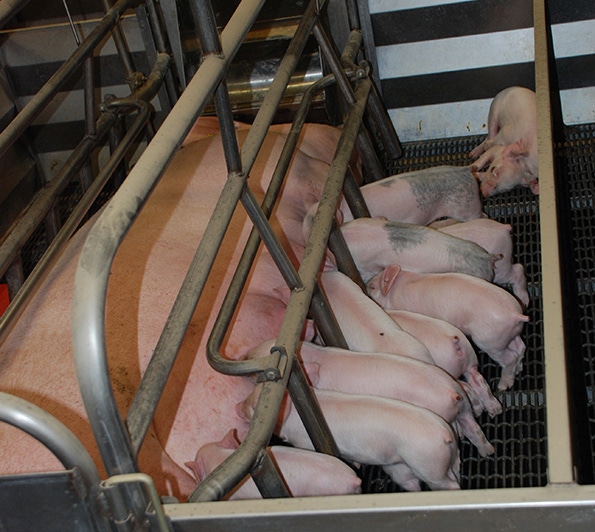3 key issues for hog producer success

“The last year was amazing,” says Tim Loula, co-founder and veterinarian at the Swine Vet Center in St. Peter, Minn. “When you put it all together, the amount of change in one year is really amazing.”
Change is inevitable and Loula picked three main areas that pig producers can concentrate on to be successful in the new parameters being placed upon the industry. Much has been written and said about the antibiotic-use regulations that go into effect Jan. 1, and Loula says it is imperative to get ahead of the curve.
Antibiotics
“We have new laws coming into effect Jan. 1, where we have to write prescriptions and do VFDs for all the feed-grades, but one of the big things is what if we use less antibiotics? How do we do that?”
One area that Loula feels producers can help themselves in the public image of antibiotic use is to attempt to eliminate mycoplasma hyopneumoniae in finishing “because that’s where a lot of antibiotics have been placed in a lot of systems in the feed to try to prevent that cough that occurs with myco.”
Myco-free herds also better handle viral diseases such as porcine reproductive and respiratory syndrome virus and swine influenza virus. “Little disappointed the industry hasn’t embraced PRRS harder; we can get rid of PRRS,” he says. “I’m a firm believer that we should be working harder on PRRS. … if we didn’t have PRRS, we’d use a lot less antibiotics.” He also believes porcine epidemic diarrhea virus can also be eradicated from herds.
Producers and veterinarians can also do a better job getting to the bottom of pig lameness, flank sores and ear necrosis issues, he says. “That’s a solvable problem both in finding what bug’s behind it. That’s the stuff you want to get now so that when Jan. 1 rolls around you’re not having to use antibiotics in the grow-finish stage. We’re pulling those out in a big way.”
While Loula agrees great strides can be made in the reduction of antibiotics, he doesn’t see the public wish for “never ever” becoming a reality. “Never ever means you won’t treat a sick animal, and if it gets sick, you just let it die?” he says. “That just doesn’t feel right.”
Batch farrowing
When Loula graduated from veterinary school 30 years ago, he says he put all his clients on batch farrowing because it easier, handling big groups to preg. check, vaccinate, you could all-in, all-out barns. “That was a new thing 30 years ago, well it’s back and it’s back big time,” he says.
Batch farrowing isn’t just for small producers either, as Loula says they have some 1,200 and 2,500 sow farms using the new-old technique. “Those who had PED and were batch farrowing, they move them all out, cleaned up, moved in new animals and they were fine.”
Loula admits the antibiotic issue is changing the pig flow in the name of health. “It’s a pain in the butt on the sow farm; you need to get gilts into groups all at the right time. It takes a lot of work.” Common flows are five groups of sows farrowing every four weeks, while to a lesser extent some farms use 10 groups of sows farrowing every two weeks.
“We know we’re heading into an environment where we have to use less drugs, so we have to look at things that we can do to improve health,” he says.
Production
Production aspects are changing so much, with the 30 pigs per sow per year number being thrown around a lot. With those kinds of numbers, “we really need to look at how we’re tending to those pigs,” he says. “The same thing we’ve done forever, we need to attend to these pigs – make sure they get dried off, make sure they get colostrum right away. We just happen to have 15 of them now versus 10 15 years ago.”
This takes more work, more effort due to the sheer number of piglets, “but it’s a huge opportunity for a lot of farms to lower prewean mortality, just by doing a better job in the farrowing barn.”
Before a producer can hope to achieve 30 psy, they need to, and Loula says most are, get a good grasp of the breeding aspect. “We understand the breeding to get high farrowing rates today better than I ever thought we would,” he says. “We don’t breed our ‘junk’ sows, there are better AI techniques.” He sees no reason farms can’t get 92 to 94% farrowing rates, “which 15 years ago I would have never said we’d be there. But we are there and we are achieving it, and we’re not breeding the repeats or the abort sows, and it doesn’t seem to be hurting us.”
Loula's presentation began and ended with a quote, that should be a motto for hog producers as they move forward in the industry: “He who does best is who gets to do it.”
Loula was one of four speakers at a Hubbard Feeds Swine Production Seminar in Okoboji, Iowa.
About the Author(s)
You May Also Like



